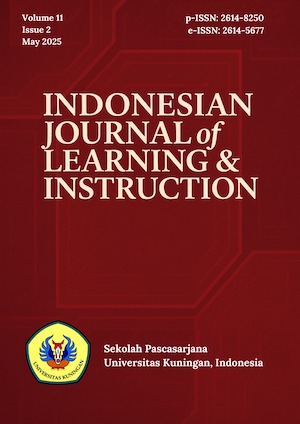MULTIPLE INTELLIGENCE AND STUDENTS’ LEARNING MOTIVATION THROUGH DEMONSTRATION WITH OUTDOOR ACTIVITIES
Abstract
This research is motivated by learning that is still dominantly carried out in the classroom, learning emphasizes more on the aspects of knowledge, so students feel bored and lack the awareness to care for the environment well, lack of concern for the surrounding environment. The ability of students who are still lacking in terms of classifying the types of plant leaves shows Biology learning requires a different learning method, one of which is using the Demonstration with Outdoor Activities Method. The purpose of this study is to analyze Multiple Intelligence and Student Learning Motivation through Demonstration Method with Outdoor Activities. The research method used is weak experimental research design The One-Group Pretest-Posttest Design. The instruments used in this study were multiple intelligence questions, observation sheets and questionnaires. The results showed that the application of the Demonstration with Outdoor Activities Method can increase multiple intelligence and Student Learning Motivation, because the Demonstration with Outdoor Activities Method is learning done outside the classroom by means of students practicing and being invited to look for material learned, so learning does not feel boring. Based on the results of the study, it was concluded that there was an increase in Multiple Intelligences and student learning motivation through the application of the Demonstration with Outdoor Activities method.
Keywords: multiple intelligence; motivation; demonstration; outdoor activities.
References
Anderson, L.W. & D.R. Krathwohl. ( 2001). Kerangka Landasan Untuk Pembelajaran, Pengajaran Dan Asesmen Agung Prihantoro (penerjemah). Yogyakarta : Pustaka Pelajar.
Ardimen. (2016). Pengembangan multiple intelligence melalui pembelajaran integratif berbasis games. Jurnal Edukasi, 2(2), 107-129.
Arends, R.I. (2008). Learning to Teach (Seventh Edition). New York: Mc Graw-Hill Companies.
Arikunto, S. (2007). Dasar-Dasar Evaluasi Pendidikan. Jakarta: Bumi Aksara.
Asiah. (2014). Penerapan metode outdoor activity dalam pembelajaran IPA untuk meningkatkan hasil belajar siswa sekolah dasar. JPGSD, 02(3), 1-11.
Blum., Niss, B., & Stein, B. S. (2010). How to Assess Higher-Order Thingking Skills In Your Classroom. Alexandria: Virginia USA, ASCD.
Emda, A. (2017). Kedudukan motivasi belajar siswa dalam pembelajaran. Lantanida Journal, 5(2), 93-196.
Erlangga, A. (2014). Pengaruh metode pembelajaran demonstrasi terhadap minat belajar siswa kelas X di SMK Negeri 3 Singaraja. e jurnal JJPTE, 3(1), 125-135.
Fraenkel, J. R & Wallen, N. E. (2007). How to Design and Evaluate Reseach in Education. San Francisco: McGraw-Hill Higer Education.
Gangadevi.S, Ravi. (2014). Multiple intelligence based curriculum to enhance inclusive education to bring out human potential. International Journal of Advanced Research. 2(8), 619-626.
Hasan, N. (2017). Penerapan multiple intelligences guna menumbuh kembangkan kreatifitas siswa-siswi di SMK Kartika Grati, Kabupaten Pasuruan. Jurnal Kajian Islam, 2(1), 134-142.
Herliani, R.N. (2015). Penerapan metode demonstration with outdoor activities dalam mata pelajaran sosiologi materi perilaku menyimpang untuk meningkatkan motivasi dan hasil belajar siswa kelas X IPS MAN Kota Blitar. Jurnal Penelitian Sosial dan Ekonomi Kehutanan. 2(1).
Khasanah, Dwiastuti, & Nurmiyati. (2016). The influence of guided discovery learning model toward scientific literacy based on naturalist intelligence. Proceeding Biology Education Conference. 13(1), 346-351.
Lazear, D. (2004). Higher-Order Thinking the Multiple Intelligences Way. Chicago : Zephyr Press.
Lismaya, L. (2011). Penerapan pembelajaran everyone is a teacher here pengaruhnya terhadap kemampuan argumentasi dan prestasi mahasiswa biologi (tingkat I) FKIP UNIKU. Quagga Jurnal Pendidikan dan Biologi. 3(1), 35-45.
Lismaya, L. (2018). Improving student’s naturalist intelligence through outdoor activities on plant morphology learning. Indonesian Journal of Learning & Instruction. 1(1), 47-52.
Nababan. (2019). Penerapan model pembelajaran outdoor activity dalam meningkatkan hasil belajar geografi. Jurnal Global Edukasi, 3(1), 13-18.
Nugroho, Hanik. (2016). Implementation of outdoor learning to improve students cognitive learning outcomes on high plant systematics course. Bioedukasi. 9(1), 41-44.
Rohim, Asmana. (2018). Efektivitas pembelajaran di luar kelas (outdoor activities) dengan pendekatan PMRI. Jurnal Elektronik Pembelajaran Matematika. 5(3), 217-229.
Sudjana, N. (2010). Dasar-Dasar Proses Belajar Mengajar. Bandung: Sinar baru algesindo.
Sugiyono. 2010. Metode Penelitian Pendidikan Pendekatan Kuantitatif, Kualitatif dan R&D. Bandung: Alfabeta.
Sukitman. (2015). Konsep pembelajaran multiple intelligence dalam pendidikan IPS di Sekolah Dasar. Jurnal Ilmiah Fakultas Keguruan dan Ilmu Pendidikan, 18(1), 1-12.
Wibawa, C. (2007). Perbedaan efektivitas metode demonstrasi dengan pemutaran video pemberantasan DBD terhadap peningkatan pengetahuan dan sikap siswa. Jurnal Promosi Kesehatan Indonesia, 2(2), 145-156.
Uno, B.H. (2011). Teori Motivasi dan Pengukurannya: Analisis di bidang Pendidikan. Jakarta: Bumi aksara.









